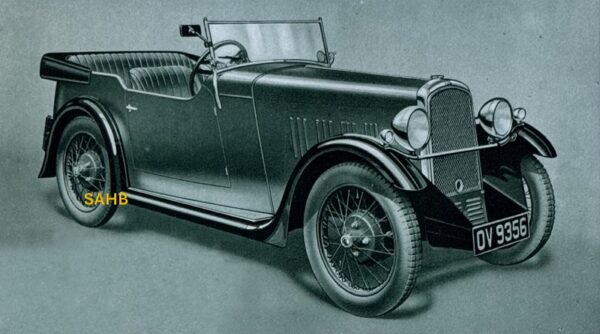
The BSA (or, according to the company’s own advertisements in 1933, the B.S.A.) has appeared in Snapshots before, in numbers 20 and 249, but this Snapshot relates to the front-wheel-drive cars built between 1929 and 1939. The most commonly remembered are possibly the three-wheelers of this type, but there were four-wheelers as well and this, the 9 h.p., was, according to the BSA Front Wheel Drive Club, built between 1932 and 1935.
After having produced several models of rear-wheel-drive four-wheelers in two periods – 1907 to 1915 and then 1921 to 1926 – BSA considered many layouts as they sought to enter the market for light cars, in particular three-wheelers. Morgan was the market leader, but BSA were concerned about the need to move to a motorcycle layout with an oily chain drive, and about the heavy driving load on a single rear wheel.
The solution of front-wheel drive must therefore have seemed attractive. The first model BSA produced was thus a front-wheel-drive three-wheeler, and a well-equipped one as well: it had reverse gear, electric start and full weather protection. Another benefit of the design chosen by BSA was independent front suspension (although Morgan already had this, with its sliding-pillar set-up).
The engine in the BSA three-wheeler was a 900cc air-cooled V-twin based on a Hotchkiss design, which gave the light weight that brought the BSA under the 8cwt weight taxation limit for three-wheelers. But for 1932 the twin was replaced by a more conventional water-cooled 1075cc straight-four.
At the same time, BSA took advantage of the lack of rear-wheel drive to add a four-wheeler to the range. The open four-seater version seen in this Snapshot, the T9, was by many accounts a good car, but its relatively ‘big car’ specification gave it a severe weight problem, and although its production dates are given as 1932-1935, it is thought that not many were made after 1933.
BSA was successful with its later front-wheel-drive four-wheeler, the Scout, introduced in 1935. This was a two-seater with a conventional and attractive sporting body and the same four-cylinder engine as in the T9. It sold so well that BSA introduced a 10 h.p. version in 1937 that lasted until World War II.
Image courtesy of The Richard Roberts Archive: www.richardrobertsarchive.org.uk







Leave a Comment